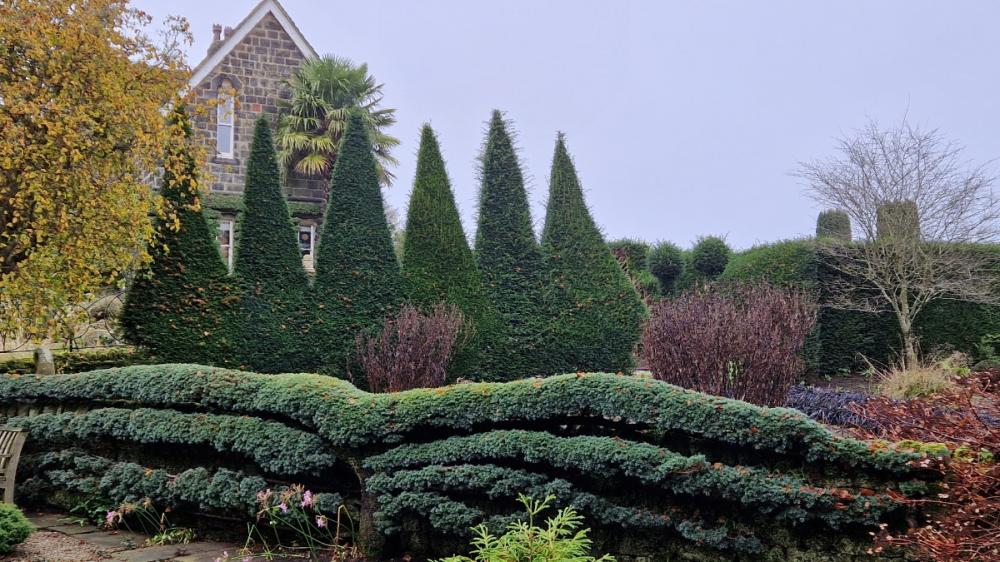search
date/time
 | Cumbria Times A Voice of the Free Press |

Andrew Palmer
Group Editor
3:00 AM 10th December 2022
nature
Capturing Garden Design At Its Best

Wynyard Hall rose garden, designed and created by Alistair Baldwin. Credit Clive Nichols
You know the kind of morning: damp and dull, the mist not yet lifted and a hue that creates a mysterious impression but my spirit is not dampened. I am driving to York Gate, in Adel, on the northern outskirts of Leeds, which is an impressive one-acre garden, the creation of Frederick and Sybil Spencer and their son Robin, now run by the charity Perennial.

The featured gardens are from across the UK, filling the pages with herbaceous borders overflowing with vibrant flower combinations, kitchen gardens that burgeon with rows of apple blossom, vegetables and sweet peas, water that cascades forever into pools and fountains and emerald-green topiary which frames a vista to a sunlit upland.
A horticultural kaleidoscope where Clive has captured the stunningly designed gardens in pin sharp detail.
In addition to meeting Clive, we are also going to be joined by Alistair W Baldwin, the landscape designer and garden maker, who recently launched the Yorkshire School of Garden Design. I have just enough time before they are meeting the gathering crowds eagerly wanting a signed copy of the book and to hear about garden design, for my interview with the duo.
As we chatted, the words of the Roman philosopher and scholar, Cicero, resonated: ‘If you have a garden and a library, you have everything you need.’
Light is my main thing. My shoots are usually first thing in the morning or late afternoon that is when you get the most flattering light,
It was not easy for Clive to choose the twenty-seven gardens that feature in the stunning book. “It was difficult, I wanted to feature gardens from all round the country, but I had to leave many out,” he tells me.
The process was hampered by Covid lockdowns which delayed production, but it also enabled Clive to add new material.
“As we were allowed to work during lockdown and there was no one in any of the gardens, I was able to get some new material. And if you remember Andrew, the weather was amazing during the lockdown.”
As we chat and look at the photos it is incredible how the images stand out with so much detail captured. According to Clive, it comes down to a garden being good structurally. York Gate, for example, has excellent topiary, walls, gates, and compartments or rooms.
“York Gate is so well put together. All very, very clever, you would not know it is small because it is divided into small rooms, so it looks bigger when you walk around. Everywhere there is a vista.”

Alistair Baldwin, Founder and Principal Tutor, Yorkshire School of Garden Design
“I thoroughly enjoyed working in the North East on Wynyard Hall’s Garden design which incorporated colonnaded walks reminiscent of the cloistered gardens of ancient Greece and Rome. It was a wonderful project. Clive understood our masterplan for this space and acknowledged this wonderful rose garden in the book.”
Yes, it is because the more of the garden you get in, the more it has to be perfect.
Clive continues in his gentle way explaining what he looks for when composing a photo. It is all about capturing the architecture, balance, beauty, and rhythm of a garden. Each has its own idiosyncrasies or the quirks that Clive is looking out for. But it is light that is most important.“Light is my main thing. My shoots are usually first thing in the morning or late afternoon that is when you get the most flattering light, it comes at a low angle and throws shadows across lawns for example.

Wynyard Hall rose garden, designed and created by Alistair Baldwin. Credit Clive Nichols
“If I know the garden, it is easier to get in the right position because I know where the sun coming up or setting.”
Clive understood our masterplan for this space and acknowledged this wonderful rose garden in the book.
Many of his photos in the book are double page spreads and I am intrigued to know if using a wide-angle lens is a challenge. “Yes, it is because the more of the garden you get in, the more it has to be perfect. If you home in on a seat it is something to target but to get a full garden scene it must be close to perfection. That is why with gardens you need to hit them at the right time. A case of being in the right place at the right time.”
Connections are important because of the inside knowledge Clive gleans from chatting to garden owners, designers, and head gardeners is crucial, they can tip him off just at the right moment when the garden is in full bloom and will look amazing.
“I am in contact with people all the time to find out when a garden will peak. If I miss it by a day or two the shot is ruined.”
As we sip our coffee Clive tells me he is an alumnus of Reading University where he studied Human Geography, and it was the course that gave him an interest in travel and leafing through his dad’s copies of Time Life and National Geographic.
He tried his hand at cheffing after university before turning to travel photography, but his Eureka moment came one day in WH Smith’s when he saw the plethora of gardening magazines. It inspired him to switch there and then.
“I took myself off to Westonbirt Arboretum in Gloucestershire, took photos and sold them the next day to Homes & Gardens for £400, a lot in the early 1980s! It snowballed from there. I knew nothing about gardens but over the years I have got increasingly into it.”
I check out where the garden is situated and from there, I zoom out to look at the surrounding area. Is it in a valley for example, or where it sits topographically...
Alistair enthusiastically says he shares similarities with Clive’s background; both fell into their respective careers by accident and travel played a major part.Alistair’s father was a UK diplomat which meant he lived in exotic cities, places such as the Middle East, Spain, and Italy.
“The first thing my mum would do when we landed was search out local parks to muck about in the evenings as the weather was so great.
“Parks in European cities are all part of the heritage and culture. We lived in Bilbao, Seville and Rome and the smells and textures of those urban areas especially in Rome where a lot of parks are at the top of the seven hills, we played among the pine trees. There was also the Ninfa Gardens which were a joy,” Alistair says.
It was the idea of people living in and around crumbly old buildings with roses, wisteria, babbling brooks and the smell of gnarly pine trees that shaped and inspired Alistair.
... the way that Alistair works is like a Michelin starred chef, understanding the community, and using the right locally sourced ingredients...
After leaving school in Bedford, he headed to Leeds Polytechnic and immediately fell in love with the city particularly the mills and blackened stone, and that he did not have to venture too far out of Leeds before he was in rolling hills, surrounded by drystone walls and craggy oak trees. “Don’t forget Andrew this was before the regeneration of Leeds. Walking round the city looking at the Corn Exchange, which was only just emerging as somewhere to be done up, the train station, canal, and the town hall, all this monumentalism, like Rome with St Peter’s, and the old part Ostia Antica.
“Those old buildings reminded me of all that and of the history on the surface, the remnants of the cloth making, the mills and railways, all still visible.
“I loved all that grit and actually, there are still a lot of people up here working with their hands, whether repairing stone walls, making gates, laying hedges.
Like Clive, Alistair exudes enthusiasm, and I ask him how his background has influenced the way he approaches a garden design project.

Kinross House in Scotland, with gardens designed and created by Alistair Baldwin. Credit Ray Cox
“It is all about having a powerful sense of place – the borrowed landscape principle. That is where I start; assessing the landscape, which can be extremely dramatic.
“Then I have to remind myself it is the owner’s garden, and they may have children coming home for university or grandchildren and I must be respectful of that.
Although during the design process it is my garden and I do know what is right for it.
As all three of us chat, Clive suggests the way that Alistair works is like a Michelin starred chef, understanding the community, and using the right locally sourced ingredients, a point with which Alistair concurs. He collaborates with joiners and other crafts people. And it is fascinating hearing how Alistair started Yorkshire School of Garden Design located in Harewood House not far away.
“I set the school up specifically to train designers to work within northern landscapes.
It is all about having a powerful sense of place – the borrowed landscape principle.
"We offer a professional Diploma in Garden Design as well as a range of short courses aimed at garden design enthusiasts and those wanting to learn more about the art, from landscaping to planting.”Both suggest as they head off to sign copies of the book and talk to the increasing number of interested people wanting to discuss photography and garden design, that I join York Gate’s head gardener Jack Ogg, who recently took over from Ben Preston, guaranteeing I will not be disappointed. And as the mist is beginning to lift and the sun has decided to wake from its slumber I am keen to look round.
Clive and Alistair are not wrong. Even in the winter the garden has an energy and aura that is captivating and fascinating, encapsulating the sentiment brilliantly in the Vita Sackville-West quotation on the back of Clive’s book: “Successful gardening is not necessarily a question of wealth, it is a question of love, taste and knowledge.”
I could not have put it better.
Brilliant English Gardens is published by Clearview Books, price £60.

Kinross House in Scotland, with gardens designed and created by Alistair Baldwin. Credit Ray Cox
Professional Diploma in Garden Design: For those interested in pursuing a career as a professional garden designer, this flagship course is delivered across the academic year, by a team of leading designers and landscapers who are all practising professionals. The course is based for two days each week, at the Grade 1 listed Harewood House between Leeds and Harrogate. The course will cover the principles of design, plants and creativity, the art of communication, a guide to domestic architecture, sustainable design, and the history of garden-making as well as practical tips to owning and running your own garden design practice.
For more information about the Yorkshire School of Garden Design, visit https://ysgd.co.uk/

York Gate
Photo: Andrew Palmer
2022 Winter Opening Times: Cafe and shop open | 2 November – 22 December 2022 | Wednesday – Sunday | 10am – 3:30pm
2023 Opening Times: Cafe open | 4 January 2023 | Wednesday – Sunday | 10am-4.30pm | Open Bank Holidays
Snowdrop Days: Friends of Perennial only - 16-19 February, 10am-3pm; General public 22-26 February, 10am-3pm | Booking opening soon
Garden, nursery and shop open | 1 April – 29 October 2022 | Wednesday – Sunday | 10am – 4.30pm | Open Bank Holidays
Groups (6+) are welcome by prior arrangement.